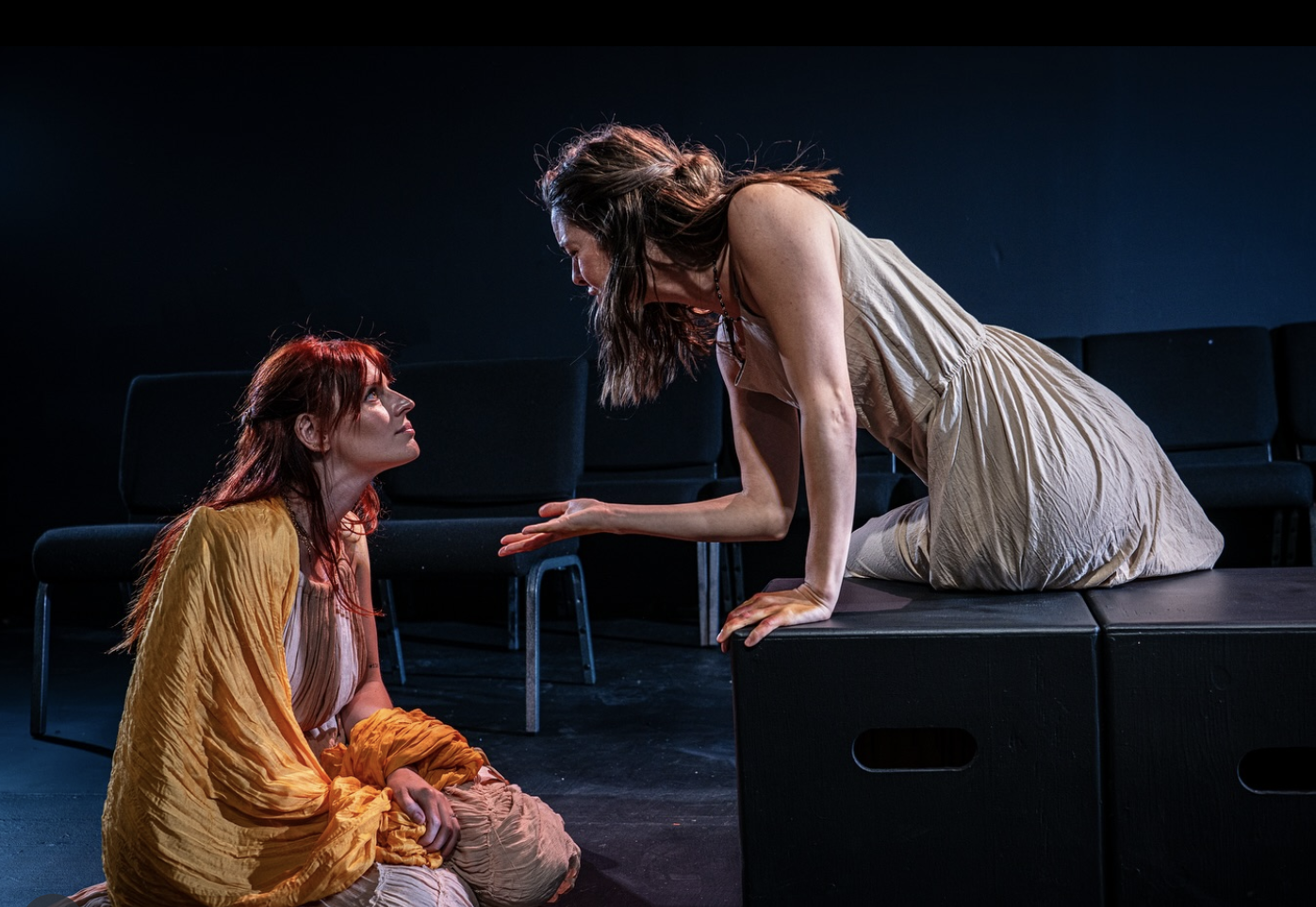Slaying Holofernes
Theatre Artemisia at Matrix Theatre
Detroit, Mich.
Aug. 9, 2025
“Let me show you how to behead a man.” Such action is generally frowned upon in polite society, but I think most would support the sentiment after watching Kiran-Durae Lambert’s Slaying Holofernes, the inaugural workshop production of feminist theater company Theatre Artemisia, which premiered at Detroit’s Matrix Theatre. The play is about the relationship between renowned Renaissance painter Artemisia Gentileschi and biblical heroine Judith, a frequent subject of Gentileschi’s work.
In addition to her celebrated artistic talent, Gentileschi is famous for surviving rape and her subsequent injustice in court, which is the focus of the story. Judith, meanwhile, is known for defeating a brutal general by seducing him and then beheading him with the help of her maid and, apparently, God himself. The play depicts the character of Artemesia’s brutal testimony of her “deflowering” as she seeks guidance and strength from Judith, who appears as a sort of hallucination to guide her (including offering the aforementioned beheading instruction).
The play opens with Judith’s story, played by Lambert. We meet the brutal, silent Holofernes (Brian Ogden), an Assyrian general who has been traveling across the country slaying defiant cities by order of the king. We learn he has just arrived in Bethulia, Judith’s city, and the leaders prepare to succumb under siege. We then see a pious woman – Judith – and her maid Abra (Colleen Gentry) approach Holofernes. Judith begins her affections, then Abra holds Holofernes’s head down as Judith brings down the blade, mirroring the Gentileschi painting on the background screen. We cut to black.

Now we meet Artemisia (Julie Kline), who is giving testimony of her rape. The trial, unlike the Judith story, is suggestive of modern times, with Artemisia taking the stand next to a robe-clad judge, opposite her rapist, who is wearing a suit.
She has accused the painter Tassi, a friend of her father’s and one of her instructors, of raping her and then breaking his promise to marry her, which would result in her ruin. A smug, loud Tassi dismisses her accusations as lies and depicts Artemisia as a loose woman who had already been with other men. We learn Artemisia has had to testify several times at this point, once under torture with “sibille,” a device with chords that pull your fingers to ensure you’re telling the truth. Tassi did not have to go through such measures, because he is a painter, and her work is not taken seriously (not yet).
Artemisia frequently dissociates, envisioning conversations with Judith that go against the traditional narrative surrounding the biblical figure. Judith tells her that God had nothing to do with her triumph over Holofernes, and Artemisia must save herself. She goes into detail about the process and difficulty of beheading a man, but somehow her own efforts and bravery are frequently diminished as impossible without divine help.
All of Act I is a build-up to both the details of the testimony and the increasingly more brutal scenes of how Holofernes really died, which are revealed in a much more exciting Act II where the female leads shine.
Through tears and fury, Artemisia’s monologue describes how her chaperone Tizia betrayed her, allowing Tassi secluded access to her while she was painting in the gallery, before he gagged her mouth and raped her. After a rather nonchalant Act I – where much of this trauma feels repressed – Kline comes alive and you feel the depth of the pain and frustration of an innocent teenager whose life is on the verge of ruin because of one man.
As we get increasingly detailed re-enactments of the Holofernes murder, Lambert embodies Judith with passion, conveying the fear, sadness and disgust of a woman whose heroic task was the result of bravery and determination, not some blessing from a divine male.
The male performances in the show were not as strong. Notably, the judge (Marceles Amiri) essentially had one mode – loud and angry, which was overkill for the story. There’s a difference between portraying a sternness to keep court in order and constantly yelling at a woman as if you had been personally wronged by her. It was stressful to watch but not in a meaningful way.
One of my favorite aspects of the play was the incorporation of art history. The real Gentileschi’s paintings were projected on stage when described, which was enlightening to see and interesting to learn about. Gentileschi is known for offering a woman’s perspective in an artistic period dominated by men. One of the examples the play gives is depictions of the biblical story of Susanna, a woman who is spied on by two elders while bathing. The character of Artemisia notes how most men depicted Susanna as passive or eroticized, as if the painters were imagining themselves as the Peeping Toms, while Gentileschi’s more realistic work shows Susanna turning away and covering herself, distressed by the male gaze.

At nearly 2.5 hours, the play is long, but doesn't need to be. Much of the dialogue is redundant, especially the Act I testimonies. Many of the monologues – especially the final epilogue – would benefit from significant editing, though the Act II rape description was impactful as is. The crux of the story and language is powerful, but that power is diluted with frequent repetition, which bordered on tedious. The few comical points of the show – though laugh-out-loud funny – were unnecessary and unbalanced with the mostly somber tone of the story and might be good candidates for the chopping block.
While Gentileschi was successful in getting Tassi convicted of rape, his punishment of exile was never enforced. Luckily, despite her ordeal, Gentileschi’s life was not ruined and she would go on to see artistic success and was able to marry and have children.
Although both the stories of Gentileschi and Judith are hundreds to thousands of years old, Slaying Holofernes depicts the ongoing struggle of women whose voices are not taken seriously and whose agency is often diminished. It also depicts the importance of female relationships, and the power and strength that is possible when we support one another.
There’s a lot of potential with Slaying Holofernes. The subject matter and characters are important, and the injustice women have suffered from for years needs to be remembered, as well as prominent female artists, heroines and leaders whose lights have been dimmed by the patriarchy. Slaying Holofernes is a promising beginning for Theatre Artemisia.





